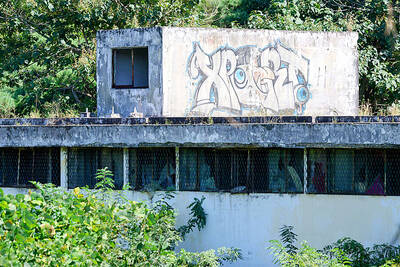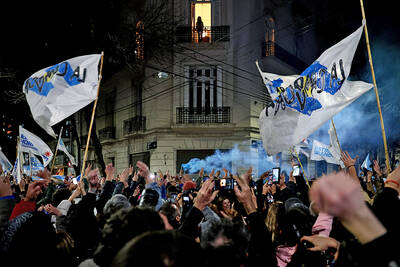Iran will have its first runoff presidential election in its history, officials said yesterday, after front-runner Ayatollah Hashemi Rafsanjani failed to win enough votes for outright victory. The main pro-reform candidate struggled for a second-place spot, trailing hard-liners.
With about three-quarters of the votes counted from Friday's presidential contest, Rafsanjani strengthened his hold on the top spot with 21.5 percent after a strong voter turnout that defied a boycott drive by dissidents.
Friday's voting showed a large turnout in a resounding rejection of a youth-led boycott -- with lines of voters forcing polling to continue four hours overtime. Iran's hard-line leaders crowed that US President George W. Bush helped fuel the turnout by sharply criticizing the elections as undemocratic and angering many Iranians. A day before the election, Bush sharply denounced the vote, saying it was designed to keep power in the hands of the clerics. But some Iranians said they were motivated to vote to retaliate against Bush's denunciations.
``I picked Ahmadinejad to slap America in the face,'' said Mahdi Mirmalek after attending Friday prayers at Tehran University.
The race for No. 2 -- and a place in the two-man second round election next week -- was up for grabs. Conservatives were making a strong showing. Mahdi Karroubi, the former parliament speaker, held the second spot with 20.2 percent. Karroubi is a close a close ally of Iran's Supreme Leader Ayatollah Ali Khamenei, who heads the non-elected theocracy. Karroubi was trailed by Tehran's conservative mayor, Mahmoud Ahmedinejad, with 17.2 percent.
The top pro-reform candidate, Mostafa Moin, had fallen to fifth place with 14.3 percent, behind Mohammad Bagher Qalibaf, a former head of the national police, with 15.2 percent.
The final outcome -- expected yesterday -- could significantly reshuffle the race for runner-up. City voters favored Rafsanjani and Moin, a former culture minister. A run-off is needed in Iran's tightest presidential election since the 1979 Iranian Revolution.

LANDMARK CASE: ‘Every night we were dragged to US soldiers and sexually abused. Every week we were forced to undergo venereal disease tests,’ a victim said More than 100 South Korean women who were forced to work as prostitutes for US soldiers stationed in the country have filed a landmark lawsuit accusing Washington of abuse, their lawyers said yesterday. Historians and activists say tens of thousands of South Korean women worked for state-sanctioned brothels from the 1950s to 1980s, serving US troops stationed in country to protect the South from North Korea. In 2022, South Korea’s top court ruled that the government had illegally “established, managed and operated” such brothels for the US military, ordering it to pay about 120 plaintiffs compensation. Last week, 117 victims

China on Monday announced its first ever sanctions against an individual Japanese lawmaker, targeting China-born Hei Seki for “spreading fallacies” on issues such as Taiwan, Hong Kong and disputed islands, prompting a protest from Tokyo. Beijing has an ongoing spat with Tokyo over islands in the East China Sea claimed by both countries, and considers foreign criticism on sensitive political topics to be acts of interference. Seki, a naturalised Japanese citizen, “spread false information, colluded with Japanese anti-China forces, and wantonly attacked and smeared China”, foreign ministry spokesman Lin Jian told reporters on Monday. “For his own selfish interests, (Seki)

Argentine President Javier Milei on Sunday vowed to “accelerate” his libertarian reforms after a crushing defeat in Buenos Aires provincial elections. The 54-year-old economist has slashed public spending, dismissed tens of thousands of public employees and led a major deregulation drive since taking office in December 2023. He acknowledged his party’s “clear defeat” by the center-left Peronist movement in the elections to the legislature of Buenos Aires province, the country’s economic powerhouse. A deflated-sounding Milei admitted to unspecified “mistakes” which he vowed to “correct,” but said he would not be swayed “one millimeter” from his reform agenda. “We will deepen and accelerate it,” he

‘HYANGDO’: A South Korean lawmaker said there was no credible evidence to support rumors that Kim Jong-un has a son with a disability or who is studying abroad South Korea’s spy agency yesterday said that North Korean leader Kim Jong-un’s daughter, Kim Ju-ae, who last week accompanied him on a high-profile visit to Beijing, is understood to be his recognized successor. The teenager drew global attention when she made her first official overseas trip with her father, as he met with Chinese President Xi Jinping (習近平) and Russian President Vladimir Putin. Analysts have long seen her as Kim’s likely successor, although some have suggested she has an older brother who is being secretly groomed as the next leader. The South Korean National Intelligence Service (NIS) “assesses that she [Kim Ju-ae]